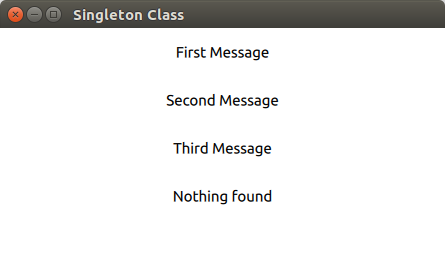Registering a QML Type as a Singleton object
In addition to C ++ classes in QML, Singleton can also use QML types, which are separate QML files.
This is also used by qmlRegisterSingletonType , but in order for this type to work as a singleton of the object, it is necessary to register the pragma Singleton in the QML file itself.
Let’s make a small application that will also output several messages, while messages will be picked up through the Singleton QML Type method.

Project structure
- SingletonQML.pro – project profile
- main.cpp – File with main function
- main.qml – Main QML file
- Util.qml – Singleton QML
The project profile will be created by default and will not be changed.
main.cpp
As the Singleton object use the file Util.qml. To make it a Singleton, it must be registered with qmlRegisterSingletonType, and also specify the pragma Singleton directive in it. First, we will register it.
#include <QGuiApplication>
#include <QQmlApplicationEngine>
#include <QtQml> // We connect to use the qmlRegisterSingletonType function
int main(int argc, char *argv[])
{
QGuiApplication app(argc, argv);
// We register the qml file by specifying its path.
qmlRegisterSingletonType(QUrl("qrc:/Util.qml"), "Util", 1, 0, "Util");
QQmlApplicationEngine engine;
engine.load(QUrl(QStringLiteral("qrc:/main.qml")));
if (engine.rootObjects().isEmpty())
return -1;
return app.exec();
}Util.qml
In this file, be sure to specify the directive pragma Singleton.
pragma Singleton // We indicate that this QML Type is a singleton
import QtQuick 2.0
Item {
function getMessage(messageNumber)
{
switch(messageNumber)
{
case 1:
return "First Message"
case 2:
return "Second Message"
case 3:
return "Third Message"
default:
return "Nothing found"
}
}
}main.qml
And now we use the singleton object to output text using this function.
import QtQuick 2.5
import QtQuick.Window 2.2
import QtQuick.Controls 1.4
import Util 1.0 // Thus, the import of QML singleton
Window {
visible: true
width: 640
height: 480
title: qsTr("Singleton Class")
ListView {
anchors.fill: parent
delegate: Item {
height: 48
width: parent.width
Text {
anchors.fill: parent
text: model.text
verticalAlignment: Text.AlignVCenter
horizontalAlignment: Text.AlignHCenter
}
}
model: listModel
}
ListModel {
id: listModel
Component.onCompleted: {
// The appeal to the singleton method looks like a call to the static method
listModel.append({'text': Util.getMessage(1)})
listModel.append({'text': Util.getMessage(2)})
listModel.append({'text': Util.getMessage(3)})
listModel.append({'text': Util.getMessage(4)})
}
}
}Conclusion
In this way, you can use singleton QML objects to emulate the use of static methods, and this is the right approach for working with similar functionality.

